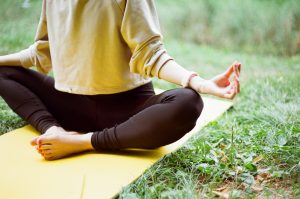42 First Person: Yoga as Medicine for Bipolar Disorder
BY AUM (FULL NAME WITHHELD)

A childhood friend from my old Los Angeles neighborhood passed away in July, the same way that my sister, D’Arcy, died: by a drug-overdose. Both my sister and Susie experienced untreated bipolar disorder-related addiction.
Susie’s affluent, educated Hollywood friends did not have the language skills to address Susie’s issues in the last couple of years. My family was the same when D’Arcy died: baffled and stammering and traumatized by years of suffering and unexplainable behavior.
Susie and I had communicated via internet in the last few years but the shame that she and her family felt about the disorder overrode the possibility of Susie seeking treatment. Shame was generationally engrained and, even today, it is not considered polite to discuss mental illness in her family. Susie is survived by a six-year old daughter.
Bipolar disorder knows no bounds. It affects all races, religions, social classes and both genders equally.
Bipolar disorder knows no bounds. It affects all races, religions, social classes and both genders equally. Bipolar disorder symptoms are ragefully painful. Though street drugs may alleviate the discomfort of symptoms, there are safer alternatives and they must be made widely available to those who suffer.
Here are 12 pain management suggestions to practice on and off the yoga mat:
- Practice ahimsa or non-animosity, first for yourself and your feelings, for your body and for your mind. This will transfer to your behavior toward others. Your self-acceptance will be your contribution to the world.
- Sit with the pain, stay with the pain, breathe through the pain, and allow the pain to subside. Find a breathing technique that you love, like exhaling longer than your inhale.
- Be mindful of the effects of the disorder, both on and off the mat. Paths to emotional stability and sobriety often merge from several sources.
- Be mindful of the breath in all charged situations, and especially in emotional situations.
- Seek out trauma-informed therapists for self-reflection and to stop emotional and physical gripping. Encourage your vital energy to flow through you, naturally.
- Fill your life with people in whom you can confide.
- Be honest with yourself.
- Strengthen and enliven your body gently.
- Move your breath to nourish and cleanse your organs, glands, bones, blood and brain.
- Let your breath do the subtle, healing work. You do not have to be responsible for everything.
- Remember that your experiences are not your nature.
- Indulge in true rest wherever possible, including in restorative yoga poses, time spent in silence and in nature.
Enjoy comfort and serenity on and off the mat.